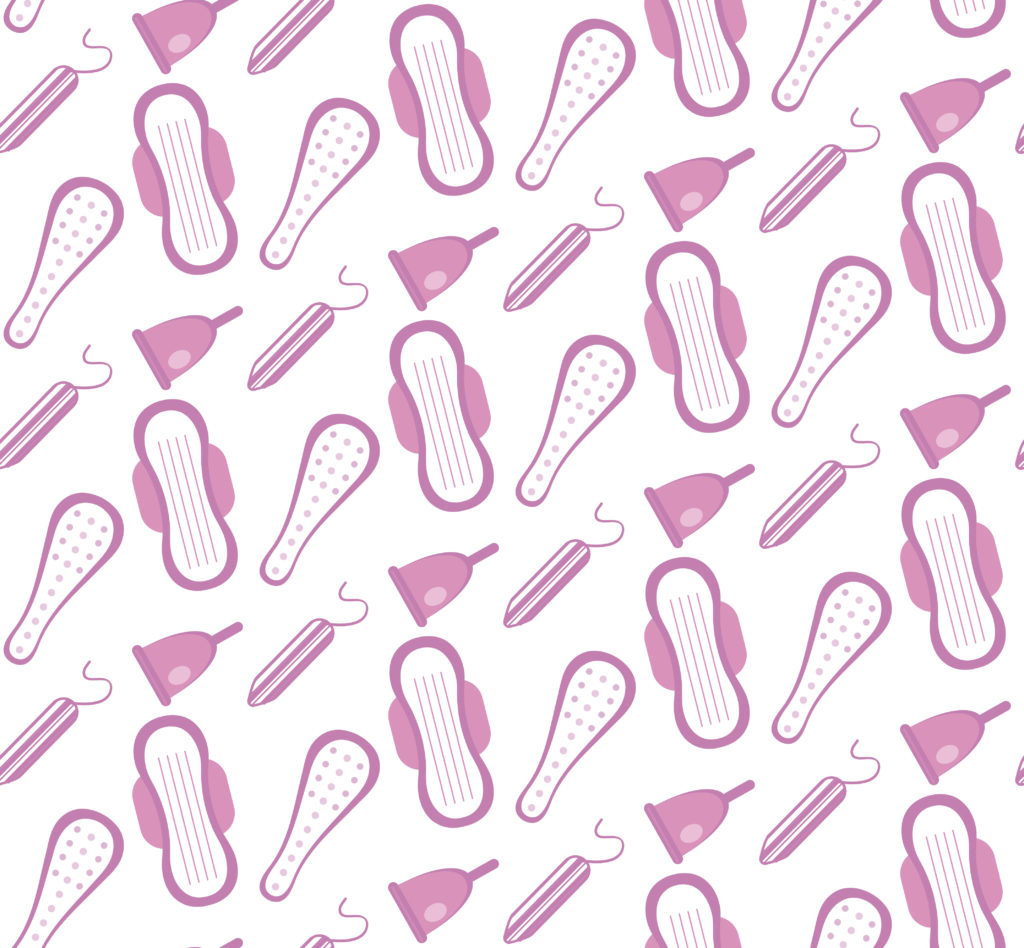There are many things blogger Cait Taylor didn’t envision herself doing in life. Searching “How To Insert A Menstrual Cup” on YouTube whilst holding a hand mirror and balancing with one leg up on the bath, is one of them. Writing about it for Miss FQ is another. And yet, here she is.
Six months ago I didn’t even know what a bloody (pun seriously unintended) menstrual cup was. I may have been acquainted with Aunt Flow since 2008, but back then my mum had informed me there were only two options for dealing with the blood that came flying outta my lady parts once a month: pads, or tampons. I’d ended up wearing a pad for a total of 30 minutes before deciding that sitting in my own blood just wasn’t for me. So, team tampon it was. And for the past nine years of menstruating, I’ve been quite happy to quickly pop one ‘up there’ and forget about it.
However, being a self-confessed health freak, over the years I have become more aware of the risks associated with tampon use. And I’m not just talking about the rare but life-threatening ‘Toxic Shock Syndrome’ ’cause it turns out that’s the least of our worries. Research shows a wide range of chemicals are used in the tampon AND pad making process, a couple of which the EPA have deemed “probable human carcinogens” A.K.A substances capable of causing cancer (eek!). As if this isn’t bad enough, our vaginas are super absorbent (absorbing chemicals at 10-80 times the rate that we do orally), potentially making the safety of feminine hygiene products the biggest women’s health issue no one is paying attention to.
I was shocked to learn this but totally stuck for solutions. So I did what any Millennial would do, and turned to Google to ask: “Are there any alternatives to pads and tampons?”
And voila. What popped up? Menstrual cups.
Who knew? Not me, that’s for sure!

Basically, menstrual cups are little cup-shaped (obvs) pieces of hypoallergenic, medical-grade silicone – no BPA or nasty chemicals! They are inserted into the vagina just like a tampon but can be worn for up to 12 hours! And instead of absorbing everything (like a tampon does), it just collects it all instead, so your natural balance is protected. All you need to do is simply empty it into the toilet once it’s full, rinse, and reinsert. Though the initial cost is around $40-$50, if you care for your cup you can use it for up to TEN years – which means you get to kiss goodbye to buying ridiculously priced tampons every month. Plus, there is no environmental waste. So practically everyone is winning! Except perhaps the squeamish among us…
Now, as someone who has used not only tampons but specifically applicator tampons my whole life… it’s safe to say I’m the kinda gal that has always preferred not to see, touch or acknowledge the blood coming from my vagina every four weeks. So when I first heard about menstrual cups, naturally my immediate reaction was “uh, gag… thanks but no thanks“. But as I learned more and more about the benefits of cups (and the risks of the alternate options), I actually started coming around to the idea.
The tipping point was when I began seeing reviews written by women who had suffered extreme period pain and found that using a cup had reduced their cramps significantly. As an endometriosis sufferer, I’d usually spend period-week rolling around on the bathroom floor in debilitating agony, downing copious amounts of pain killers and seriously debating a hysterectomy. Luckily, I was willing to try anything before resorting to the latter. Even a menstrual cup. So I decided to bite the bullet and jump online, credit card at the ready, and search ‘menstrual cups NZ’.
The first issue was that I didn’t even know which cup to buy, as there are SO many different kinds. I tried doing a bit of research but found lots of conflicting info and opinions. In the end, I kinda winged it and opted for the small LENA cup, simply because it has been rated the #1 best menstrual cup for beginners (also I’ll admit, I kinda just loved their branding! haha). Then I anxiously awaited the postman for about a week, until finally, the little bugger arrived in my mailbox. I ripped open the package pronto, eager to find out what this thing really looked like IRL. My first reaction: It’s smaller than I imagined. And it’s pink (how cute). This is going to be a breeze.
My period was still a week away but I was eager to do a test run. So a few minutes later I had a leg up on the bath, LENA cup in one hand and the instructions in the other. To insert the cup you have to fold it so it’s small when it goes in, but can pop open once in the right place. It’ll then make a leak-free seal around the vagina wall and you can forget about it for the next 12 hours. Of course, this is all dependent on you actually getting it in, in the first place. I tried all the various folds.. the C-fold, the Punch-down fold, the 7-fold and a few that I totally made up myself in a desperate attempt to get the damn thing up there. To sum it up in two words: Not Happening. I even triple coated it in coconut oil but after about 45 minutes of trying I was still getting nowhere. Huh. Maybe I’d been a wee bit too optimistic…
Related video: How to insert a menstrual cup
Luckily my mother didn’t raise a quitter, and I wasn’t okay with a little piece of pink silicone getting one over on me. So a couple days later, hand in hand with my pride, I headed back to the bathroom for fight #2. The main issue was that I’d get it partially in, but then it’d pop open too soon – which hurt, you guys! But after taking a deep breath and really trying to relax, I managed to get it in on the second try. Turns out that is the key here ladies – you absolutely have to relax. But unfortunately, as overjoyed as I was to get it in… turns out that was the easy part. I then spent the next hour trying to get the thing out! Again: harder than it seems but it just takes practice. It has a little stem to help you remove it, and it’s impossible for it to get lost up there, so you just gotta chill and keep trying.
When my period finally arrived, I hopped in the shower, folded my LENA into a C-fold and actually got it in straight away! And for the first time EVER… my period pain was about a 6/10, instead of an 11/10. We’re talking serious miracle stuff here! My mind was blown and in that moment I knew I wouldn’t be going back to tampons. I wore the cup teamed with pads for the first couple days as you can experience some leaking (I did have a little) until you figure out the best placement. Towards the end of my period, I was experiencing no leaks and could happily go sans pads. I wore it to work, to yoga class, and to sleep at night with no issues. It was just like wearing a tampon, except it was comfier – I couldn’t feel it at all! And each time I inserted and removed it, it became easier and easier to do. I’ll admit it was a little weird seeing my blood in a cup like that but after using it for a while, I was unfazed by it. After all, period blood is actually not gross. It’s 100% normal. We just have to get used to seeing it that way.
And that’s that! I have now been using a menstrual cup for over six months and can confidently say I’ll be using one for many, many years to come. No more running to the supermarket for tampons, no more health risks, no more damage to the environment, and no more unbearable period pain (thank goodness!). And in an era where we’re all stressing about toxins, being eco-friendly and the absurd “luxury” tampon tax, I’m predicting that menstrual cups just may be the new chia seed. Just wait and see!
MY TIPS:
- Don’t go into it with the expectation that it’s gonna be easy (like I did)… you’ll only end up throwing your arms in the air questioning how you can possibly feel so inept with your own body.
- Persevere, keep practising, use lube if it’s easiest and in the meantime, you’ll get to know your vagina way better than before. Which is actually kinda cool.
- I find the C-fold the easiest (personal preference). I also recommend folding it and then trying to put it in fairly swiftly, that way you don’t allow it enough time to pop open prematurely. I always seem to run into that issue when I put it in too slowly.
- I put my cup in while I’m in the shower and I change it in there too, I prefer to properly wash myself and the cup each time. Seeing as you only have to change it every 12 hours, this isn’t a big deal for me but if you find it more convenient you can simply empty in the toilet, rinse and reinsert.
- DON’T give up just because there’s a box of tampons sitting there waiting to be used without the hassle. You can do this. I believe in you!












